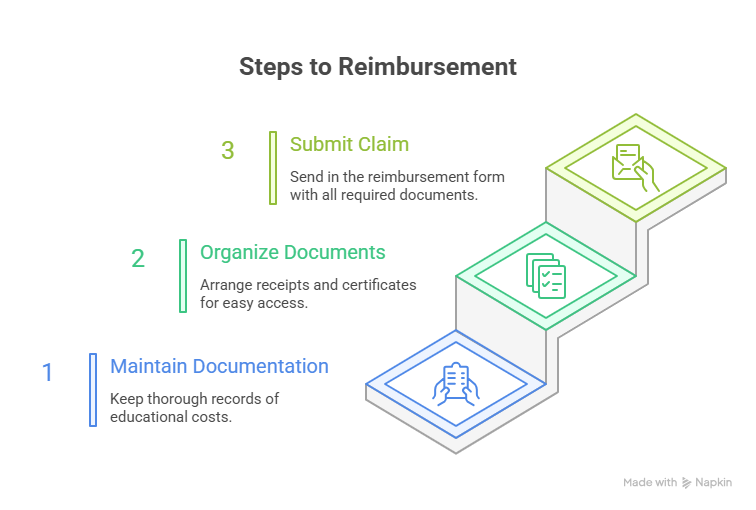Millions of American professionals are eligible to receive reimbursement for continuing education costs; did you know that? This benefit is a great tool for people who want to grow in their careers without spending a lot of money.
It doesn’t have to be difficult to claim reimbursement for continuing education. You can obtain the money required to pursue additional training or certifications by taking a few simple actions.
This manual will guide you through the procedure, giving you precise instructions on how to successfully complete the reimbursement process. Knowing how to submit a reimbursement claim is essential, regardless of whether you want to improve your abilities or fulfill professional development requirements.
Understanding Education Reimbursement Benefits
Employees who want to continue their education without facing heavy financial obligations must comprehend the education reimbursement process. Since they understand how important continuing education is to their employees’ professional development and the success of the business, many employers include this benefit in their total compensation package.
What Is Continuing Education Reimbursement?
Employers’ financial support for employees to cover the costs of continuing their education is known as continuing education reimbursement. Courses, certifications, and degree programs that improve job performance or get workers ready for new positions within the organization can fall under this category.
Types of Education Expenses Typically Covered
Tuition, books, and occasionally even travel expenses for attending conferences or educational events are covered by the majority of employer-sponsored education benefits. The particular costs that are covered can differ significantly based on the company’s policy.
Checking Your Company’s Education Reimbursement Policy
Employees should first become acquainted with their company’s reimbursement policy in order to benefit from education reimbursement. This entails being aware of the requirements for eligibility, the kinds of costs that are covered, and how reimbursement claims are submitted. Understanding the annual maximum reimbursement amount is also crucial.
Continuing Education Reimbursement Steps: The Complete Process
There are a few crucial steps in the continuing education reimbursement process that can help guarantee you receive payment for your educational costs. Take careful note of these steps to get the most out of your employer’s employee education assistance program.
Step 1: Research Your Company’s Policy Requirements
It’s critical to comprehend your company’s professional development reimbursement policy prior to enrolling in any courses. To find out what kinds of classes and costs are covered by reimbursement, check your employee handbook or speak with HR.
Step 2: Get Pre-Approval Before Enrolling
You must get pre-approved by many companies before you can sign up for a course. By taking this step, you can be sure that your course satisfies the employer’s tuition assistance requirements. Send your HR department a pre-approval request form or email with information about the course, its cost, and how it relates to your work.
Step 3: Maintain Required Documentation
You must maintain thorough records of your educational costs in order to be eligible for reimbursement. This comprises:
- Tuition and other course material receipts
- Certificates of course completion
- Grade reports or transcripts
Essential Documents to Keep
Make sure you have all the paperwork you need to back up your reimbursement claim, including certificates and receipts.
Organizing Your Receipts and Certificates
To facilitate access to your documents when needed, keep them organized in a folder or digital file.
Step 4: Submit Your Reimbursement Claim
After finishing your course, send in your reimbursement claim along with the necessary paperwork. Be sure to:
- Complete the reimbursement form accurately.
- Include all required documents.
- Meet the deadline for submissions.

Filling Out Reimbursement Forms Correctly
Make sure all the information on the reimbursement form is correct and complete.
Meeting Submission Deadlines
To prevent losing the chance for reimbursement, be mindful of the due date for filing your claim.
Step 5: Follow Up on Your Claim
Make sure your claim is being processed by following up with your HR department after submitting it. If necessary, be ready to offer more details.
What to Do If Your Claim Is Denied
If your claim is turned down, find out why it was turned down. You might have to appeal the ruling or resubmit your claim with more details.
Maximizing Your Education Reimbursement Benefits
Making the most of the continuing education funding guidelines requires an understanding of your company’s education reimbursement policy. You can successfully submit a claim for reimbursement of your educational costs by following the instructions provided in this article.
In summary, it’s critical to learn about your company’s policy requirements, get pre-approved prior to enrolling, keep the necessary records, and file your reimbursement claim. Understanding the guidelines for funding continuing education will make the process easier for you to handle.
You can improve your career prospects and make an investment in your professional development by utilizing your company’s education reimbursement policy. Keep yourself informed, plan ahead, and take advantage of all the opportunities that present themselves.
FAQ
What is the first step in claiming continuing education reimbursement?
Investigating your company’s policy requirements is the first step. This includes learning about the kinds of educational expenses that are covered, how reimbursement works, and whether any special paperwork is required.
How do I get pre-approval for a course before enrolling?
You usually need to send a pre-approval form or request to your supervisor or HR department in order to receive pre-approval. This form should include information about the course, such as its name, provider, cost, and how it relates to your job or career development.
What kind of documentation do I need to keep for reimbursement?
Essential records like receipts, completion certificates, and any other evidence of payment or involvement should be preserved. Keeping your certificates and receipts in a specific folder or digital file is also a smart idea.
How do I submit a reimbursement claim?
Usually, in order to file a reimbursement claim, you must complete a reimbursement form, include the necessary supporting documentation, and send it to the appropriate department or individual within the allotted time.
What if my reimbursement claim is denied?
In the event that your claim is rejected, you should check the reason for the denial, make sure you fulfill the policy’s requirements, and, if required, submit your claim again. If there are any inconsistencies, you might also want to follow up with your supervisor or HR.
Can I claim reimbursement for online courses?
Online courses are often covered by companies’ education reimbursement policies. To find out if online courses are acceptable and what particular requirements or limitations might be in place, check your company’s policy.
Are there any deadlines for submitting reimbursement claims?
Yes, the majority of businesses have due dates for filing claims for reimbursement. To avoid missing the deadline, be sure to review your company’s policy and make appropriate plans.
How long does it take to receive reimbursement after submitting a claim?
Each company has a different processing time for reimbursement claims. It usually takes a few days to more than a few weeks. For a more precise timeframe, ask your supervisor or human resources representative.




